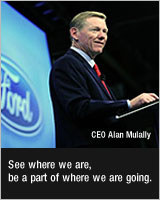For Henry Ford, excellent treatment of employees was a given, and he constantly sought out ways to improve his workers' conditions and lives.

Early on, Ford had shocked his business and industrial contemporaries by creating the $5 workday, and then he instituted programs to teach his employees how to spend their new high wages responsibly, cut an hour off the standard workday and provided on-the-job educational facilities. He also insisted on stringently high standards of cleanliness and safety, especially for the time, in the working environment. So when labor unions began to form, he opposed them because he felt that he and his company could—and should—be responsible for meeting all the needs of his workers.
As union organizers focused on Ford Motor Company, Henry decided to entrust the company's response to one of his key executives, Harry Bennett, a powerful figure with a reputation for toughness. The result was a period of confrontation that included violence and bloodshed, including the "Battle of the Overpass" in 1937. The UAW eventually won the right to organize the workers at Ford Motor Company. The first contract was signed in 1941. Henry's son, Edsel, was instrumental in getting the company to negotiate and sign a contract with the union.
Although Henry Ford considered the unionization of his company as his "greatest disappointment" in business, Ford Motor Company and the union proceeded to work together over the decades to ensure continually improving conditions for workers.
Learning to Work TogetherIn the 1940s and 1950s, Edsel's son Henry II picked up where his father left off. He became one of the first automotive executives to establish a practice of collaborating with the UAW. In a landmark 1946 speech, he laid out the company's new approach and set the stage for much more harmonious relations with the UAW in the years that followed.
As Henry II's tenure continued, the UAW grew and strengthened, securing pensions and health benefits, along with other benefits that cemented the relationship. In the 1980s and 1990s, Ford and the UAW took another leap forward together, strengthening the relationship through joint policies and programs focused on quality, production methods, and workers and their families.
About the UAWFormed as the United Automobile Workers union in Detroit in 1935, the UAW remains one of the largest unions in the United States. In the decades following the early struggles, the UAW has been a potent and forceful leader in collective bargaining on behalf of workers and their families.
In the mid-1990s, the UAW broadened its scope to represent workers in other fields, including aerospace, trucking and agriculture, as well as technical, office and professional industries and services.



